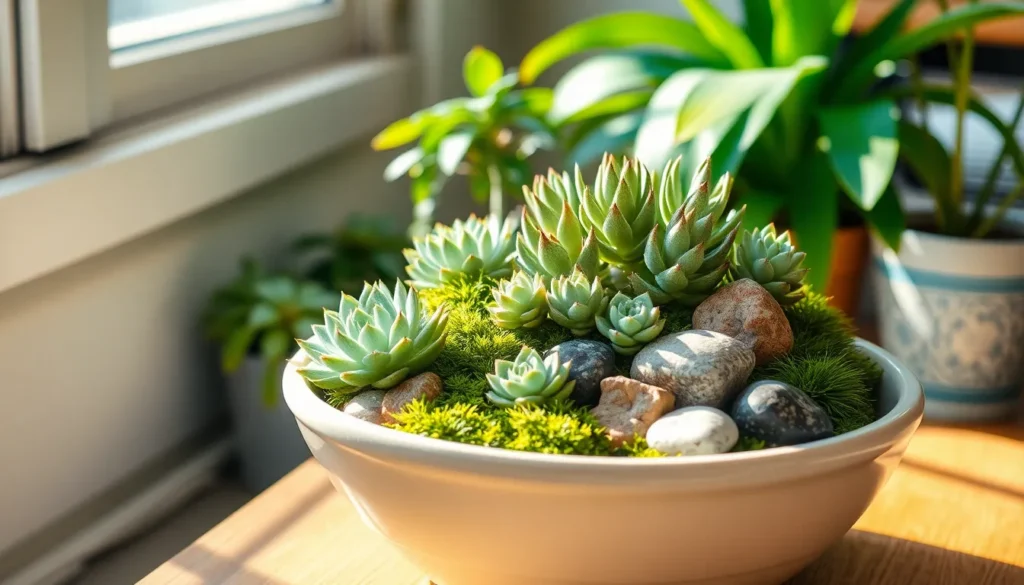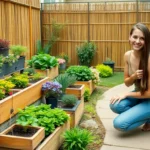Transform your living space with the enchanting industry of dish gardens – miniature landscapes that bring nature’s beauty indoors without requiring a green thumb or acres of space. We’ve discovered that these captivating container gardens aren’t just decorative pieces; they’re living artworks that create stunning focal points in any room while purifying your air naturally.
Creating your own dish garden opens up endless possibilities for creativity and self-expression. Whether you’re drawn to desert succulents cascading over weathered driftwood or prefer lush tropical arrangements featuring delicate ferns and moss, we’ll show you how to create these botanical masterpieces using everyday containers you already own.
The best part? Dish gardens require minimal maintenance while delivering maximum visual impact. We’ve tested countless combinations and techniques to bring you foolproof ideas that work for beginners and seasoned gardeners alike. From selecting the perfect plants to mastering proper drainage these compact ecosystems will transform your home into a green sanctuary.
Choose the Perfect Container for Your Dish Garden
Selecting the right container sets the foundation for your dish garden’s success and visual appeal. We’ll explore three popular container categories that offer unique advantages for different plant combinations and design aesthetics.
Glass Bowls and Terrariums
Clear glass containers showcase your miniature industry from every angle while creating stunning light effects throughout your space. We recommend fishbowls, glass serving dishes, and purpose-built terrariums for their excellent visibility and humidity retention capabilities.
Open glass bowls work perfectly for succulent arrangements since they provide proper air circulation and prevent moisture buildup. These containers typically range from 6 to 12 inches in diameter and offer easy access for maintenance and plant adjustments.
Closed terrarium systems create ideal environments for tropical plants like ferns, moss, and small flowering varieties. The enclosed design maintains consistent humidity levels while reducing watering frequency to once every few weeks.
Glass apothecary jars add vintage charm to your dish garden collection and work exceptionally well for single-specimen displays or air plant arrangements. Their narrow openings create unique planting challenges that result in distinctive design outcomes.
Ceramic Dishes and Planters
Decorative ceramic bowls complement traditional home decor while providing excellent drainage options through pre-drilled holes or added drainage layers. We suggest selecting containers between 8 to 14 inches wide for optimal plant spacing and root development.
Glazed ceramic planters resist water damage and offer countless color options to match your interior design scheme. These containers work particularly well for herb gardens, small vegetable displays, and flowering plant combinations.
Unglazed terracotta dishes provide natural moisture regulation through their porous surfaces, making them ideal for plants that prefer drier conditions. Their earthy appearance enhances rustic and Mediterranean-themed dish gardens.
Ceramic serving platters create shallow planting areas perfect for succulent collections, moss gardens, and miniature industry scenes. Their wide surface area allows for creative arrangement patterns and multiple plant varieties.
Repurposed Household Items
Vintage teacups and saucers transform into charming individual plant holders for small succulents, air plants, or single herb specimens. We’ve successfully used mismatched china sets to create eclectic collections with personality and character.
Wooden salad bowls offer natural aesthetics that complement both modern and rustic interiors while providing ample space for larger plant arrangements. These containers require waterproof liners to prevent damage from moisture exposure.
Metal colanders and strainers work excellently for hanging dish gardens or elevated displays due to their built-in drainage systems. Their industrial appearance suits contemporary spaces and urban gardening themes.
Vintage cake pans and baking dishes provide perfect shallow depths for moss gardens, succulent arrangements, and miniature zen landscapes. We recommend using copper, enamelware, or stainless steel varieties for their durability and unique visual appeal.
Select Low-Maintenance Plants for Easy Care
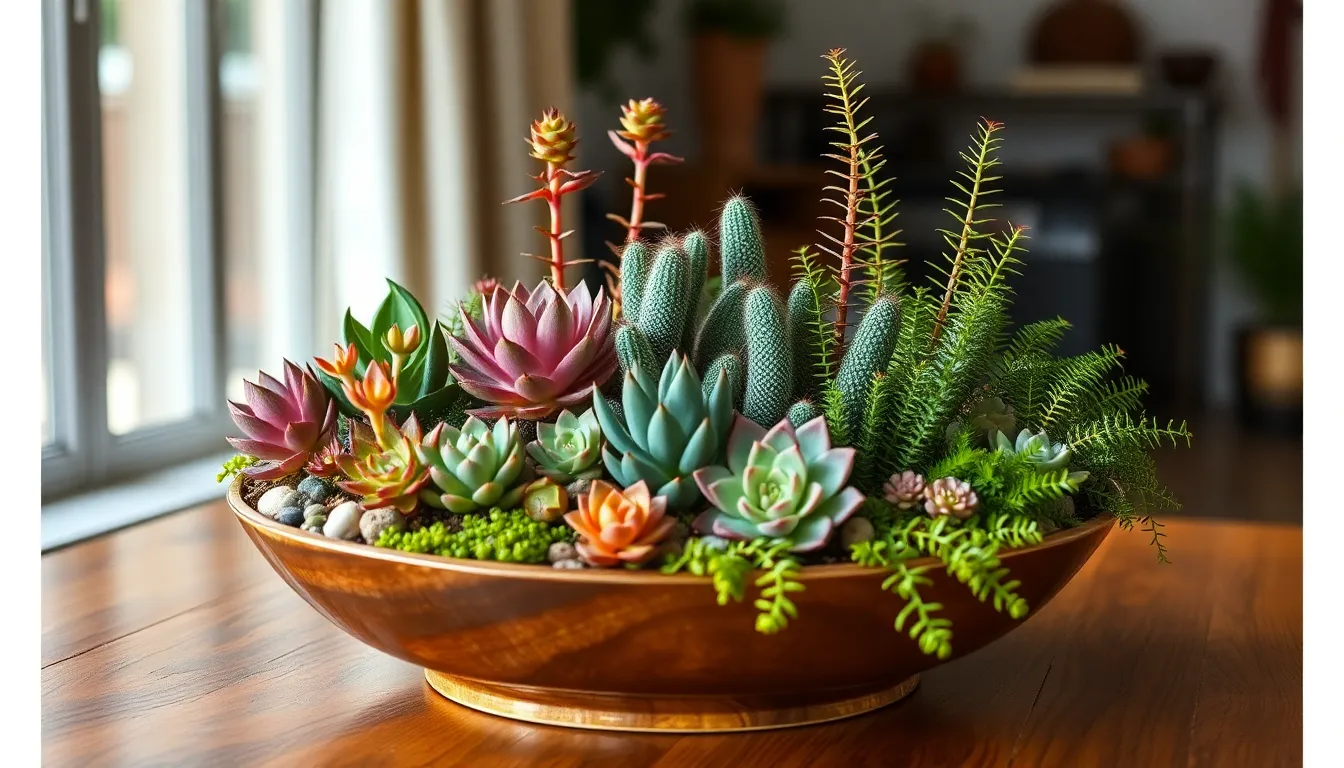
Once you’ve chosen your perfect container, selecting the right plants becomes crucial for creating a thriving dish garden that won’t overwhelm your schedule. We’ll focus on varieties that flourish with minimal attention while delivering maximum visual impact.
Succulents and Cacti Varieties
Succulents provide the ultimate low maintenance option for dish garden enthusiasts. These drought tolerant plants store water in their thick leaves and stems, requiring watering only every 2-3 weeks. We recommend combining echeveria with jade plants and string of pearls for textural variety in your arrangement.
Cacti offer even greater drought resistance than most succulents. Barrel cacti, prickly pear, and golden barrel varieties create striking focal points while needing water just once monthly. You can mix different cactus sizes and shapes to add visual depth without increasing care requirements.
Both plant types thrive in bright, indirect light and well draining soil. They’ll signal when they need water by showing slightly wrinkled leaves or soil that feels completely dry several inches down.
Air Plants and Tillandsia
Air plants eliminate soil maintenance entirely since they absorb nutrients and moisture from the air around them. These epiphytes attach to decorative elements like driftwood, shells, or decorative stones without any potting medium. We suggest misting them 2-3 times weekly and providing bright, filtered light for optimal growth.
Tillandsia varieties offer incredible diversity in size, color, and form. Spanish moss creates cascading effects, while tillandsia xerographica forms stunning silver rosettes that serve as natural centerpieces. Purple tillandsia cyanea produces vibrant blooms that last several weeks.
Most air plants prefer temperatures between 50-90°F and benefit from occasional soaking sessions every 1-2 weeks. Simply submerge them in room temperature water for 20-30 minutes, then shake off excess moisture.
Small Ferns and Mosses
Small ferns bring lush greenery to dish gardens while requiring only consistent moisture and indirect light. Button ferns, maidenhair ferns, and baby Boston ferns stay compact and create beautiful textural contrasts with other plants. These varieties prefer humidity levels around 40-50% and weekly watering when the top inch of soil feels dry.
Mosses serve as living ground cover that requires minimal maintenance once established. Sheet moss, cushion moss, and mood moss varieties spread naturally and help retain soil moisture for companion plants. They thrive in low to medium light conditions and need only light misting every few days.
Combining ferns with mosses creates a miniature forest floor effect that’s both visually appealing and functionally beneficial. The moss helps regulate moisture levels while the ferns add vertical interest and natural air purification properties to your indoor space.
Create Themed Dish Garden Designs
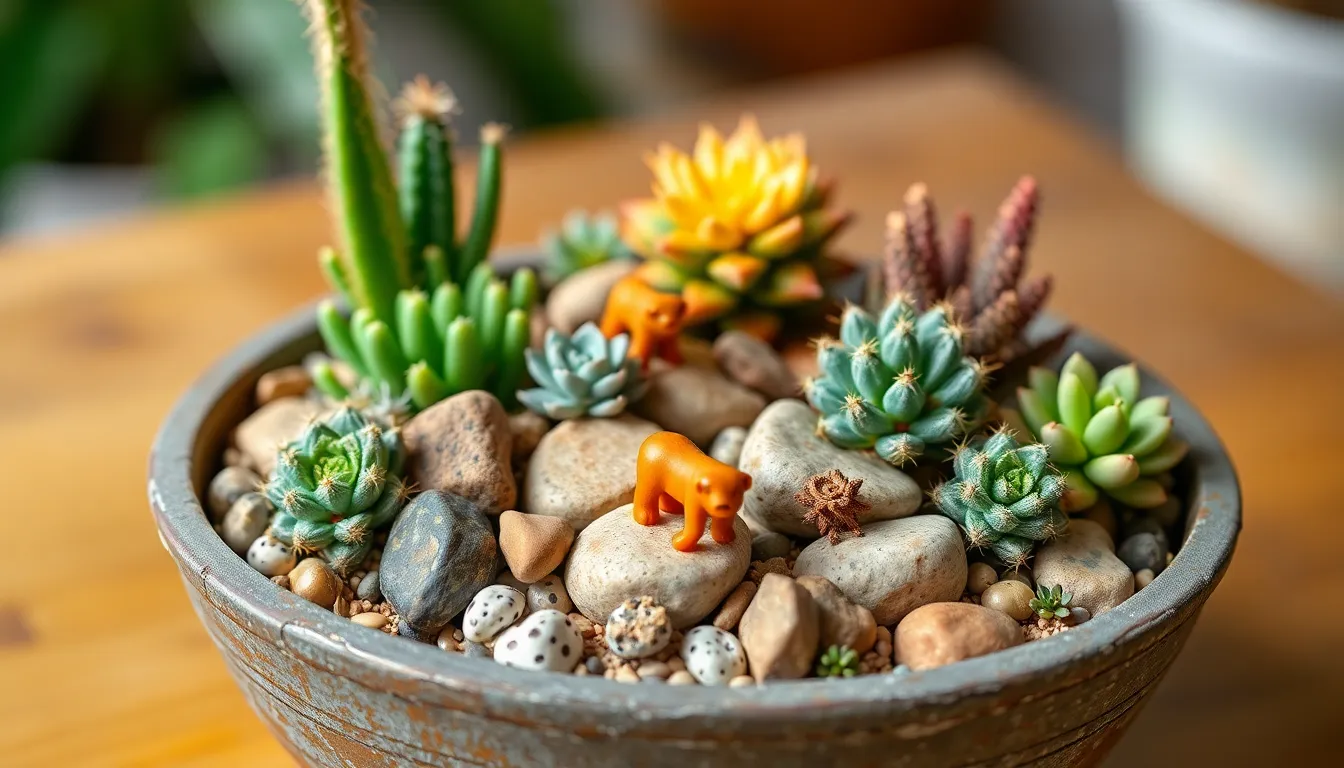
Themed dish gardens transform ordinary containers into captivating miniature worlds that reflect your personal style and interests. We’ll explore three popular design approaches that bring distinct aesthetics and moods to your indoor space.
Desert Industry Gardens
Desert landscapes capture the rugged beauty of arid environments through carefully selected cacti and succulents that thrive in low water conditions. We recommend combining various textures and sizes of desert plants like barrel cacti, prickly pear, and jade plants to create visual depth and authentic desert appeal.
Incorporating small rocks or pebbles into your design mimics natural desert terrain while providing proper drainage for your plants. Consider adding decorative elements such as small animal figurines or miniature cactus sculptures to enhance the southwestern atmosphere and create captivating focal points within your desert scene.
Fairy Tale Miniature Gardens
Fairy tale gardens evoke whimsy and fantasy through moss covered landscapes, tiny colorful flowers, and enchanting miniature structures that spark imagination. We suggest using moss as your base foundation while incorporating small flowering plants like baby tears or miniature violets to add pops of color throughout your magical industry.
Decorative elements like miniature furniture, tiny bridges, or fairy figurines transform your dish garden into a storytelling centerpiece that captivates both children and adults. Choose plants with different colors and textures such as small ferns, colorful moss varieties, and delicate flowering plants to create depth and visual interest that brings your fairy tale industry to life.
Zen and Meditation Gardens
Zen gardens emphasize simplicity and harmony through natural elements like carefully placed stones and soft moss that promote tranquility and mindfulness. We focus on minimalism by using a limited palette of plants such as sheet moss and small ornamental grasses that create a peaceful, uncluttered aesthetic.
Decorative stones or small water features enhance the meditative atmosphere while maintaining the clean, serene look essential to zen design principles. Select a simple, elegant container that complements the minimalist theme and allows the natural beauty of your carefully chosen elements to take center stage in your meditation space.
Layer Your Dish Garden for Proper Drainage
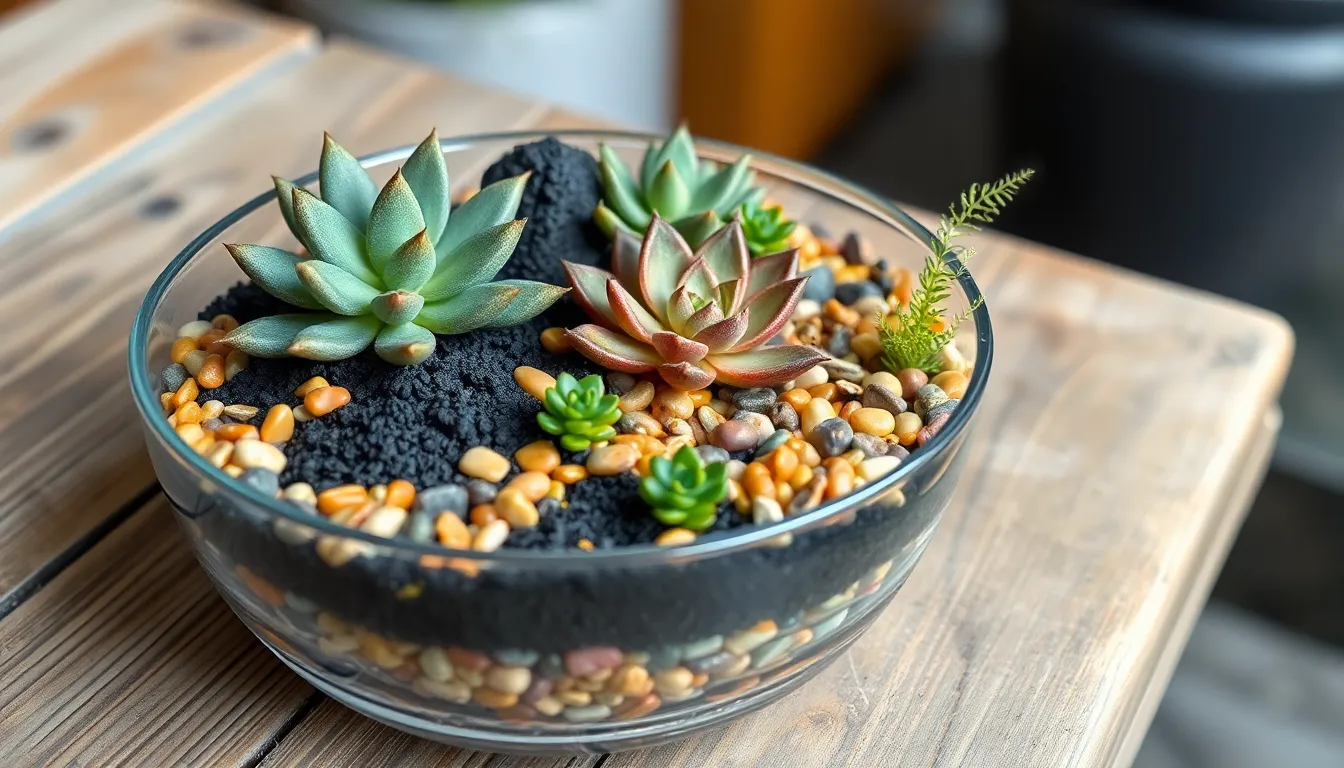
Building a successful dish garden requires proper layering to prevent waterlogging and ensure healthy plant growth. We’ll guide you through the essential three-layer system that creates optimal drainage conditions for your miniature industry.
Gravel and Pebble Base Layer
Gravel and pebbles form the foundation that prevents water from accumulating in your container. Small river rocks, aquarium gravel, or decorative pebbles work perfectly for this crucial base layer. We recommend using materials that are ¼ to ½ inch in size for optimal water flow and root health.
Create a base layer that’s approximately 1 to 2 inches deep, depending on your container size. Deeper containers need thicker drainage layers, while shallow dishes require proportionally less material. Decorative colored gravel adds visual interest when using clear glass containers, allowing the drainage layer to become part of your garden’s aesthetic appeal.
Distribution should be even across the entire bottom surface to ensure consistent drainage. Uneven gravel placement creates low spots where water pools, potentially causing root rot in your plants. Small pea gravel mixed with larger decorative stones provides both function and visual texture beneath your soil layer.
Activated Charcoal for Filtration
Activated charcoal serves as a natural filtration system that prevents mold and root rot in your dish garden. This porous material absorbs excess moisture, toxins, and odors that can develop in closed container environments. We find that horticultural grade activated charcoal works best for plant applications.
Sprinkle a thin layer of activated charcoal directly over your gravel base before adding soil. A light dusting is sufficient – you don’t need a thick layer since activated charcoal’s effectiveness comes from its surface area rather than depth. Aquarium activated charcoal or terrarium-exact products provide the right particle size for dish gardens.
Filtration improves significantly when charcoal particles are distributed evenly across the drainage layer. Clumped charcoal creates inconsistent moisture control, while properly spread material maintains consistent air quality throughout your container. This layer becomes especially important in closed or partially enclosed dish garden designs.
Quality Potting Mix Selection
Quality potting mix ensures healthy plant growth by providing good drainage and proper nutrient balance. Well-draining commercial potting mixes work better than garden soil, which becomes too compact in container environments. We recommend choosing mixes specifically formulated for your plant types – succulent blends for cacti or standard houseplant mixes for tropical varieties.
Cacti and succulent potting mixes contain additional perlite and sand for enhanced drainage. These specialized blends prevent the water retention issues that kill desert plants in dish garden settings. Standard potting mixes work well for ferns, small houseplants, and herb combinations that prefer slightly more moisture.
Soil depth should match your plants’ root requirements while leaving space for decorative elements. Most dish garden plants thrive with 2 to 4 inches of growing medium above the drainage layers. Shallow-rooted succulents need less soil depth than small ferns or herbs, allowing you to customize each section of mixed plantings accordingly.
Arrange Plants by Height and Growth Patterns

Strategic placement transforms your dish garden from a simple plant collection into a ever-changing miniature industry. We’ll create visual depth and natural harmony by organizing plants according to their mature heights and spreading tendencies.
Tall Centerpiece Plants
Dominant focal points anchor your entire dish garden composition. Small bonsai trees serve as stunning centerpieces that draw the eye upward while maintaining appropriate scale for container gardening. We recommend selecting dwarf varieties like juniper or ficus that won’t outgrow their space within the first year.
Upright succulents create dramatic vertical interest without overwhelming smaller companions. Echeveria ‘Black Prince’ and jade plants (Crassula ovata) develop impressive height while maintaining compact root systems. These specimens typically reach 6-8 inches tall, making them perfect statement pieces for medium to large dish gardens.
Columnar cacti add architectural structure to desert-themed arrangements. Golden barrel cactus and pencil cactus varieties provide striking vertical elements that complement sprawling ground covers below.
Mid-Level Filler Plants
Transitional plants bridge the gap between your centerpiece and ground level vegetation. Small flowering varieties like miniature African violets or tiny begonias add bursts of color at the 3-4 inch height range. We position these plants around the base of taller specimens to create natural layering.
Compact shrubs and herbs serve dual purposes as filler plants and functional additions. Miniature rosemary and dwarf thyme varieties reach perfect mid-level heights while contributing fragrance and texture to your dish garden composition.
Air plants mounted on decorative stands create floating mid-level interest. Tillandsia species like Spanish moss or air plant bulbs can be positioned at various heights using small branches or decorative stakes.
Ground Cover and Trailing Options
Low-growing plants create the foundation layer that unifies your entire arrangement. Sheet moss and cushion moss form lush carpets that hide exposed soil while providing rich green backgrounds for taller plants. We spread these varieties in thin layers around plant bases to achieve seamless coverage.
Trailing succulents soften container edges with graceful cascading growth. String of pearls (Senecio rowleyanus) and string of hearts (Ceropegia woodii) drape elegantly over dish garden rims, creating movement and visual flow beyond the container boundaries.
Creeping ground covers fill gaps between larger plants while preventing soil erosion. Baby tears and creeping thyme spread naturally to connect isolated plantings, creating cohesive miniature landscapes that appear established and mature.
Add Decorative Elements and Accessories
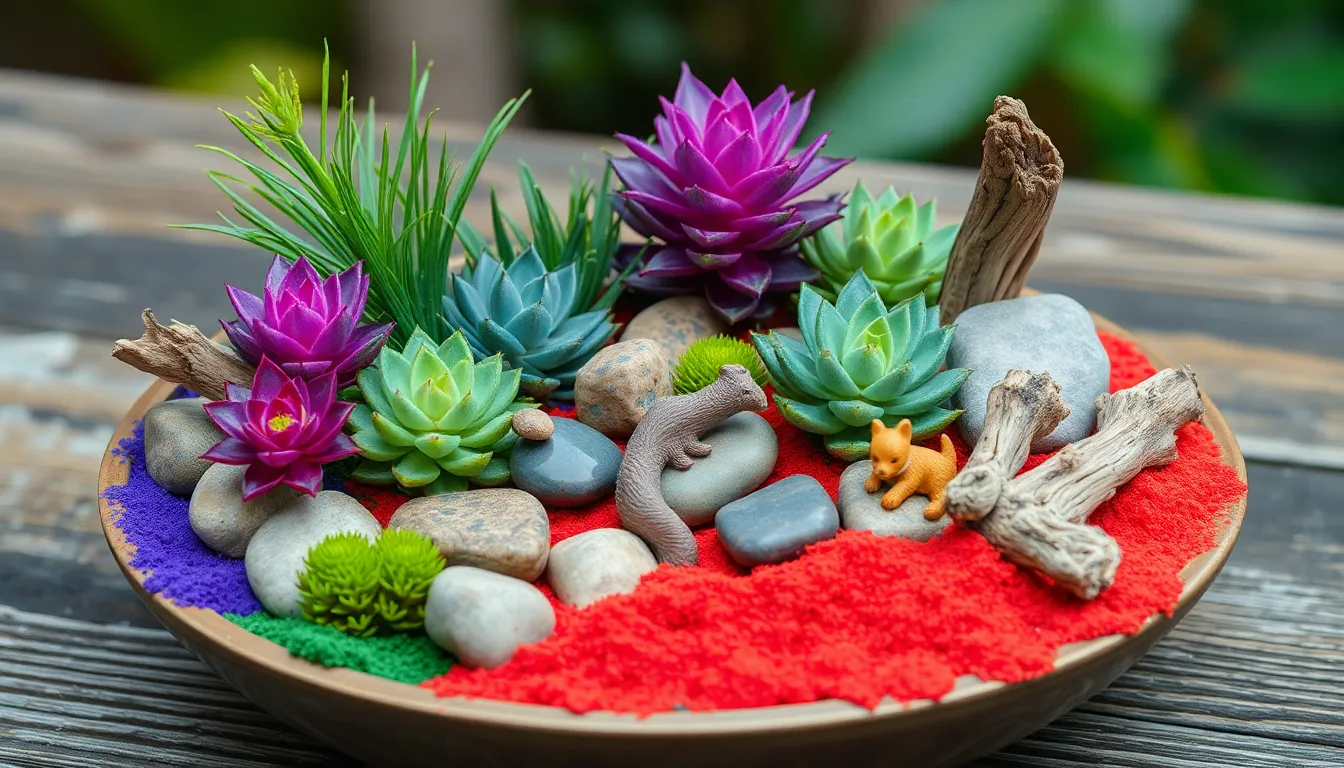
Once we’ve established our plant foundation, we can transform our dish garden into a captivating miniature industry through thoughtful decorative additions. Strategic placement of accessories creates visual interest and transforms simple plantings into enchanting landscapes.
Natural Stones and Driftwood
Incorporating natural stones and driftwood brings organic texture that complements living plants beautifully. We find that stones of various sizes work perfectly for creating miniature pathways between plant groupings or defining exact garden zones. River rocks and smooth pebbles add gentle curves that guide the eye through our arrangement naturally.
Driftwood pieces introduce rustic charm while providing structural anchors for climbing plants or trailing varieties. We love how weathered wood creates striking contrast against fresh greenery and rich soil tones. Positioning driftwood at different angles adds dimension and creates natural-looking scenes that feel authentic rather than staged.
Strategically placed stones also serve practical purposes beyond aesthetics. They help retain moisture around plant roots while improving drainage in areas where water might collect. We recommend choosing stones that echo the color palette of your container for cohesive design flow.
Miniature Figurines and Ornaments
Adding miniature figurines transforms our dish gardens into storytelling landscapes that capture imagination and create conversation pieces. Tiny animals like rabbits, deer, or birds bring life to plant arrangements and make viewers lean in for closer inspection. We particularly enjoy using small garden tools or watering cans that suggest ongoing care and cultivation.
Fairy garden ornaments open endless creative possibilities for themed displays. Miniature houses, bridges, and benches create scenes that transport viewers into magical worlds. We find that limiting figurines to 2-3 pieces prevents overcrowding while maintaining focal points that draw attention.
Seasonal ornaments keep our dish gardens fresh and relevant throughout the year. Small pumpkins work beautifully for autumn arrangements, while tiny snowmen add winter charm. We recommend choosing weather-resistant materials that won’t fade or deteriorate when exposed to plant watering routines.
Colored Sand and Decorative Rocks
Colored sand and decorative rocks serve as artistic ground cover that brightens soil surfaces and creates stunning visual contrast. Layered sand in complementary colors adds depth and definition between different plant sections. We love how vibrant sand colors can echo seasonal themes or match existing home decor palettes.
Decorative pebbles in metallic finishes like copper or silver create sophisticated looks that work well in modern settings. Multicolored glass stones catch and reflect light beautifully, adding sparkle that makes dish gardens feel more ever-changing. We find that these materials also help retain soil moisture while providing excellent drainage properties.
Creating patterns or borders with colored materials helps define pathways and plant groupings within our arrangements. Gradient effects using sand colors from light to dark create illusions of depth and movement. We recommend securing loose materials with light misting to prevent shifting during plant care activities.
Maintain Your Dish Garden for Long-Term Success
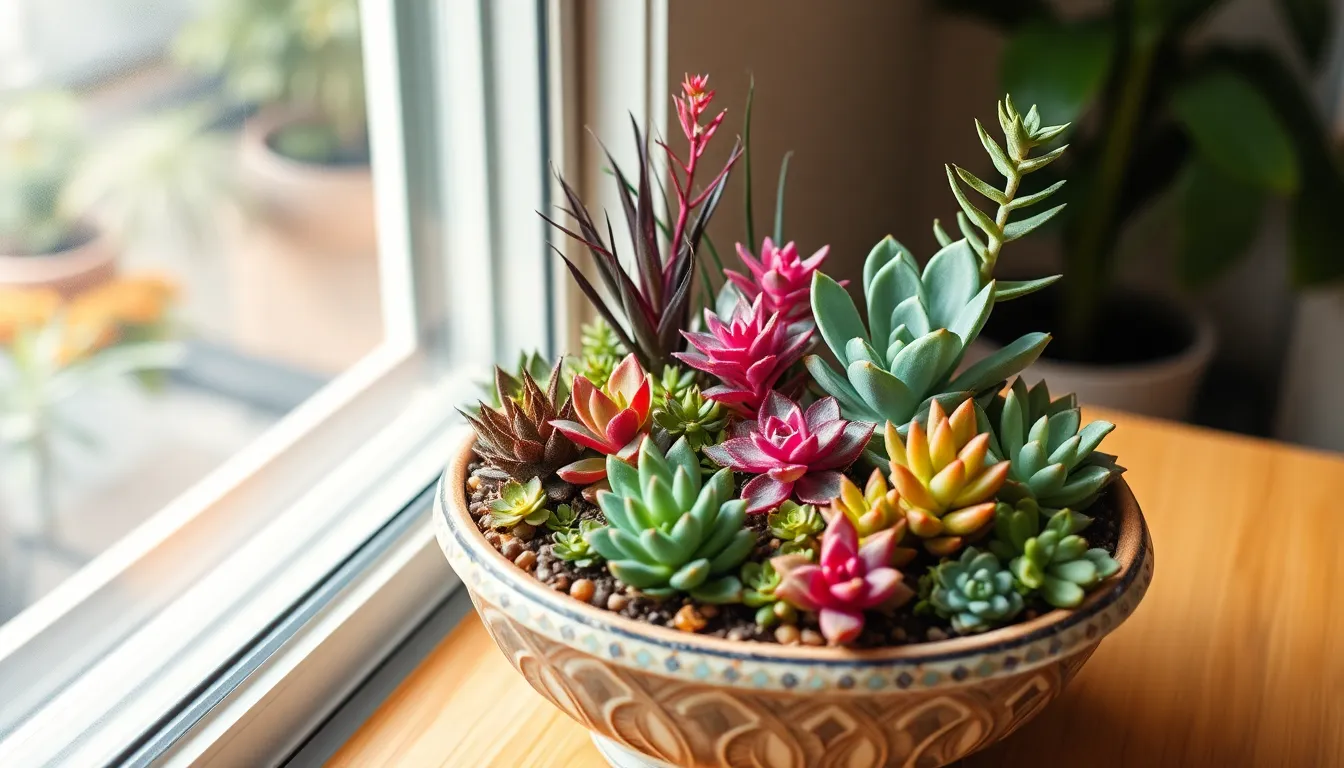
Successful dish gardens require consistent care and attention to thrive throughout the seasons. We’ll share proven techniques that ensure your miniature industry remains healthy and beautiful for years to come.
Proper Watering Techniques
Water your dish garden carefully since most containers lack proper drainage holes, making overwatering a common mistake. We recommend using a watering can with a long, thin neck to target individual plant roots without saturating the entire container. Start with watering twice weekly and adjust the frequency based on your exact plant types and environmental conditions.
Allow the soil to dry between waterings, especially for moisture-sensitive plants like succulents and cacti. Check the soil moisture by inserting your finger about an inch deep into the potting mix. Water slowly and stop when you see moisture pooling at the surface, as excess water can lead to root rot in containers without drainage.
Light Requirements and Placement
Position your dish garden according to the light needs of your plant selection for optimal growth. Most tropical dish gardens require 4-6 hours of indirect sunlight daily, thriving best near a sunny window while protected from direct exposure that can scorch delicate leaves. Green foliage plants generally tolerate medium light conditions, making them perfect for areas with filtered sunlight.
Cacti and succulents demand brighter, sunnier spots to maintain their compact growth and vibrant colors. Monitor your plants’ response to their current location and adjust placement as needed. Signs like stretching stems or pale coloration indicate insufficient light, while brown leaf edges suggest too much direct sun exposure.
Pruning and Plant Rotation
Remove dead or yellowing leaves regularly to maintain your dish garden’s appearance and prevent disease spread. We suggest using small scissors or pruning shears to make clean cuts close to the base of the plant. Inspect your garden weekly for any damaged foliage that could attract pests or harbor fungal issues.
Rotate plant positions within your dish garden if they grow at different rates to ensure even light exposure for all specimens. Address overcrowding promptly by repotting or thinning plants to maintain proper spacing and air circulation. Apply a light fertilizer application once in spring, but avoid feeding stressed or dormant plants during their resting periods.
Troubleshoot Common Dish Garden Problems
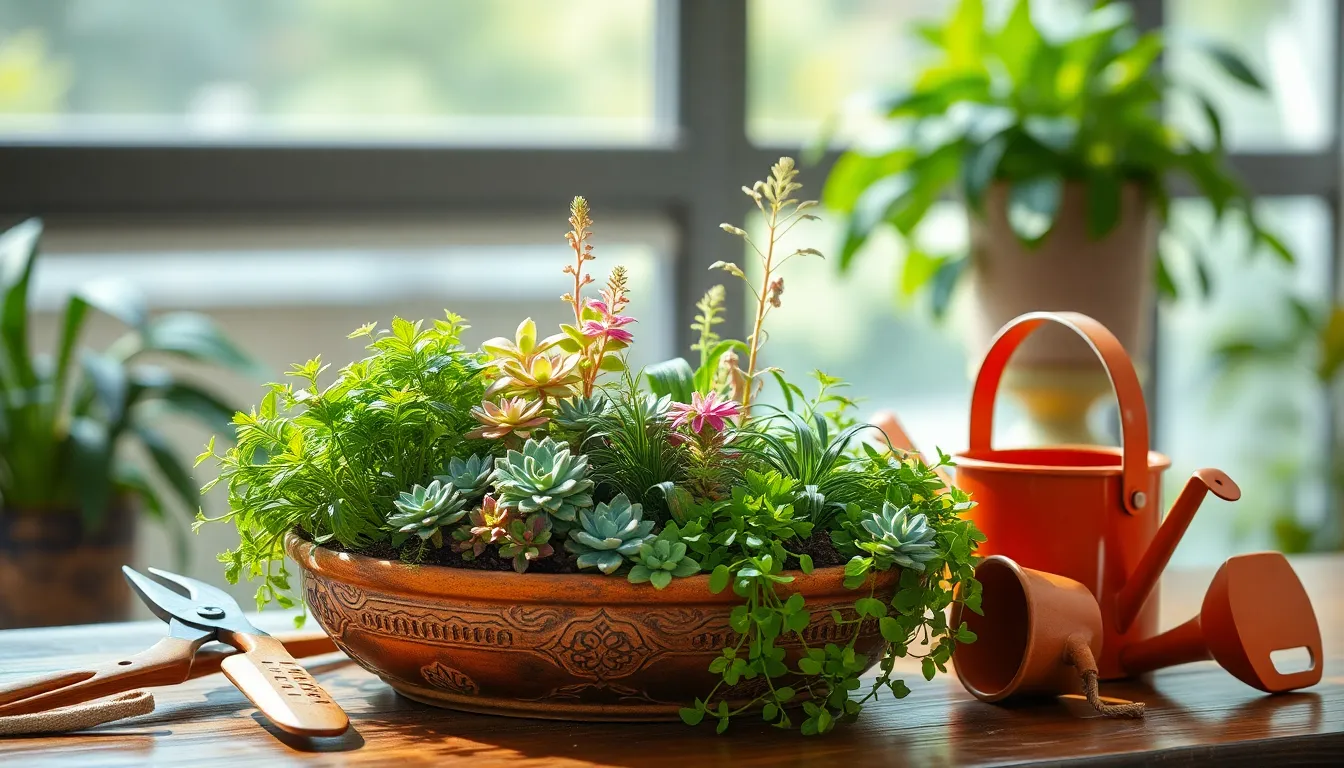
Even the most carefully planned dish gardens can encounter challenges that threaten plant health and visual appeal. We’ll guide you through identifying and resolving the most common issues to keep your miniature landscapes thriving.
Overwatering and Root Rot Issues
Overwatering ranks as the number one killer of dish garden plants, especially in containers without proper drainage holes. Yellowing leaves and soft, blackened roots serve as telltale signs that your plants are drowning rather than thriving. We recommend checking the topsoil with your finger before each watering session—only water when the surface feels completely dry to the touch.
Fast-draining soil becomes your best defense against waterlogged conditions that lead to root rot. Create a drainage layer using gravel or sand at the bottom of your container to prevent water from pooling around plant roots. Adding perlite or coarse sand to your potting mix improves water flow and prevents soil compaction that traps excess moisture.
Plants sitting in water-filled saucers face immediate danger from root rot, so we always empty drainage trays within 30 minutes of watering. Containers with poor drainage require immediate attention—drill additional holes or transfer plants to better-ventilated vessels. Prevention beats treatment when dealing with overwatering issues, so err on the side of underwatering rather than overwatering your dish garden plants.
Pest Management Answers
Aphids, mealybugs, and spider mites frequently target dish garden plants, especially when grown in warm indoor environments. Regular inspection of leaves, stems, and soil surfaces helps catch infestations before they spread throughout your entire collection. We examine our plants weekly, checking both upper and lower leaf surfaces for signs of pest activity.
Immediate isolation of affected plants prevents pests from migrating to healthy specimens in your dish garden. Remove heavily infested leaves with clean scissors, then dispose of them in sealed bags to prevent re-infestation. Insecticidal soap or neem oil provides effective, plant-safe treatment options that won’t harm your miniature network.
Early detection makes pest control significantly easier and more successful than waiting until infestations become severe. Quarantine new plants for two weeks before adding them to existing dish gardens, allowing time for hidden pests to reveal themselves. Clean tools between plants during maintenance sessions to avoid accidentally spreading pests from one area to another.
Plant Replacement Strategies
Failed plants require prompt removal to prevent disease spread and maintain the overall health of your dish garden community. We assess struggling plants by examining root systems, leaf color, and growth patterns to determine whether recovery is possible or replacement is necessary. Quick action prevents one failing plant from compromising the entire arrangement.
Replacement plants must match the light and moisture conditions of your existing dish garden network. Selecting plants with similar care requirements ensures harmony within the container and reduces the risk of future problems. We keep backup plants in similar containers to test compatibility before making permanent additions to established gardens.
Seasonal changes offer opportunities to refresh your dish garden with plants that thrive in current conditions. Rotating plants based on temperature, humidity, and light availability maintains year-round visual interest while supporting plant health. Consider the mature size of replacement plants to avoid overcrowding as they establish and grow within your miniature industry.
Conclusion
Creating dish gardens opens up endless possibilities for bringing nature into our homes while expressing our personal style. We’ve shown you how these miniature landscapes can transform any space with minimal effort and maximum visual impact.
Whether you’re drawn to desert themes with stunning succulents or prefer whimsical fairy tale gardens we’ve provided the foundation you need to succeed. The key lies in choosing the right container selecting low-maintenance plants and following proper layering techniques.
With consistent care and attention to watering light requirements and seasonal adjustments your dish gardens will thrive year-round. Start with one simple design and watch as your confidence grows along with your collection of these captivating miniature worlds.
Frequently Asked Questions
What is a dish garden and why should I create one?
A dish garden is a miniature landscape created in a shallow container that brings nature indoors without requiring extensive gardening skills or space. These living artworks serve as stunning focal points while providing air-purifying benefits. They’re perfect for busy lifestyles since they require minimal maintenance while offering maximum visual impact, making them ideal for both beginners and experienced gardeners.
What containers work best for dish gardens?
The best containers fall into three categories: glass bowls and terrariums for visibility and humidity retention, ceramic dishes and planters that complement home decor, and repurposed household items for unique displays. Unglazed terracotta helps regulate moisture, while vintage teacups and wooden bowls add charm. Choose containers that enhance visual appeal while supporting plant health.
Which plants are easiest to maintain in dish gardens?
Low-maintenance plants include succulents and cacti (like echeveria, jade plants, and string of pearls) for drought tolerance, air plants that require no soil and thrive on misting, and small ferns with mosses for lush greenery. These varieties need minimal watering and care while providing textural variety and visual interest in your miniature landscape.
What are popular dish garden themes I can create?
Three popular themes include Desert Industry Gardens featuring cacti and succulents for arid landscapes, Fairy Tale Miniature Gardens with moss and colorful flowers for whimsical appeal, and Zen Meditation Gardens emphasizing simplicity and harmony. Each theme offers unique plant combinations and decorative elements that reflect personal style and create captivating miniature worlds.
How do I properly layer my dish garden for healthy plants?
Use a three-layer system starting with gravel and pebbles for drainage at the bottom, followed by activated charcoal for filtration to prevent mold and root rot, then quality potting mix tailored to your plants’ needs. This layering technique prevents waterlogging and ensures optimal growing conditions for healthy plant development.
How should I arrange plants in my dish garden?
Arrange plants by height and growth patterns: use tall centerpiece plants like small bonsai trees to anchor the composition, mid-level filler plants such as miniature African violets to bridge gaps, and ground cover like sheet moss for unity. This strategic placement creates visual depth, harmony, and dynamic miniature landscapes.
What decorative elements can enhance my dish garden?
Incorporate natural stones and driftwood for organic texture and moisture retention, miniature figurines for storytelling landscapes, seasonal decorations to keep displays fresh, and colored sand or decorative rocks for artistic ground cover. These thoughtful additions transform simple plantings into enchanting, personalized displays that enhance visual contrast and define plant groupings.
How do I properly water my dish garden?
Use a watering can with a long neck to target individual plant roots and allow soil to dry between waterings. Avoid overwatering, which is the primary threat to dish gardens. Monitor soil moisture levels and adjust watering frequency based on plant needs and seasonal changes to maintain healthy growth.
What are the most common problems with dish gardens?
The most common issues include overwatering leading to root rot, pest infestations, and plant health decline. Recognize signs of overwatering like yellowing leaves, ensure proper drainage, conduct regular pest inspections, and use plant-safe treatments like insecticidal soap. Replace struggling plants promptly to maintain overall garden health and appearance.
How much light do dish gardens need?
Light requirements depend on your plant selection. Place gardens with succulents in bright, indirect light, while ferns prefer lower light conditions. Air plants thrive in bright, filtered light. Position your dish garden based on the specific needs of your chosen plants, and consider rotating containers periodically for even light exposure.

